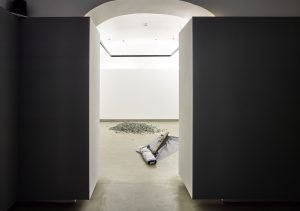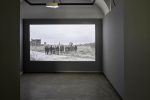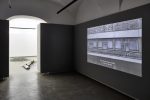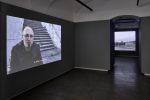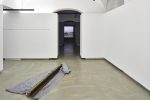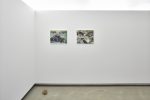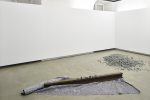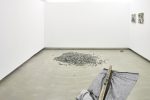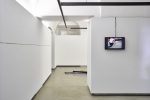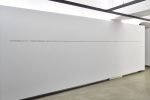stones, too, feel
Mona Vătămanu, Florin Tudor
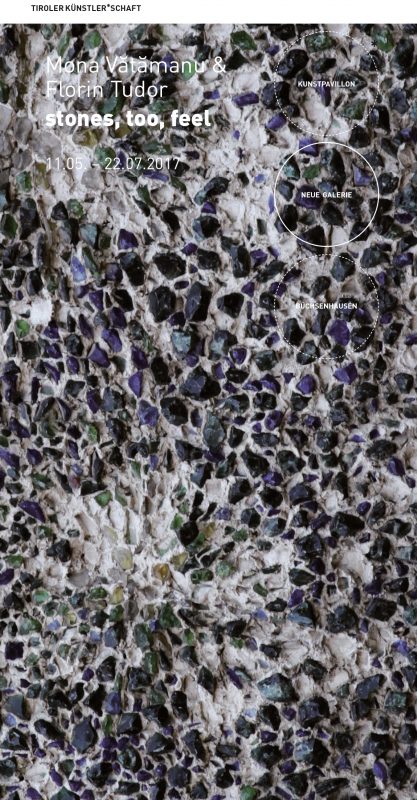
The artist couple Mona Vătămanu & Florin Tudor, who live in Bucharest, have been working on joint projects since 2000. Among other venues, they have presented them in the Romanian pavilion at the Biennale di Venezia 2007, in the New Museum, New York, Centre Pompdiou, Paris, and at the Shanghai Biennale 2014.
In their installations, films with the style of artistic documentation, performative gestures, ephemeral actions and site-specific interventions they operate with disparate elements of reality, material and immaterial. They pose questions about major social changes, economic developments and political conflicts. In their works Mona Vătămanu & Florin Tudor repeatedly confront the heritage of communism in their home country Romania and the rest of Eastern Europe with a policy of remembering otherwise suppressed and forgotten history. In this context, architecture and landscapes play a key role as sites of retaining both personal and also collective memories. Here, the creation of links to specific site-related situations becomes a universal medium of reflection. In performative re-enactments or symbolic recuperation it is not only a matter of working on suppressed history but always about the changing conditions of the present day, as well. The artists see this as essential to an understanding of contemporary society.
The exhibition stones, too, feel in the Neue Galerie deals with the themes of migration, imagination, utopia and possible alternative worlds by intertwining several narratives in a thread of symbolic associations, which confront the current oligarchic imperialism of the globalised world.
The title stones, too, feel refers to their new installation in the space at the front of the gallery. Part of a railway track lies on a cloth mat on the floor, with a small hill of rough stones beside it. An object made from matches and wool thread is close by; above this two small paintings are hung. The paintings come from the series Appointment with History. In one of them it is possible to discern the blurred figure of a small boy with dark skin, who has fallen asleep exhausted on a railway track. A photo that the artists found in the course of their research work inspired them to paint this image. The hopelessness of the scene is contrasted with metaphors of childlike play: one being the stones that lie on the track in the gallery, which children might have placed there; another is the object made from simple wool thread and matches, which is highly ambivalent when viewed more closely. Could it be associated with aggressiveness? Or is it to be understood as a symbol of creative activity, or as a model of the universe, with us all representing a part of the whole? The installation makes reference to the displaced people drama and struggle for a new life, these ‘others’ appearing in the fog of our consumer culture that blurs the condition of permanent war around the globe. The installation initiates a dialogue with the work Horizon, a thin line made from a geographic atlas that questions the very idea of horizon. Where does the horizon end, and what territorial boundaries does it delineate?
Two films can be seen on a screen in the entrance area. The first frames of the film Rite of Spring show poplar pollen clouds blown around the street by the wind. Then we see how they are instantly consumed by fire, and then the reason for this spectacle – it is children who set them on fire for fun. They are completely engrossed in this activity and fascinated by its fleeting effect. Children who are burning up the clouds of white poplar fluff: a simple and poetic gesture, which implies a promise – the promise of renewal. The sparks and small fires in the film suggest the catalyst of change to existing orders. They are reminiscent of the seas of little flames that have been lit in many places in recent years – all of which point to the hope for a more equal world.
The second film was made in the setting of a former armaments factory in Dudeşti, Bucharest. In Prapadenia pamantului /The Wretch of the Earth this site becomes a witness to humble actions and artistic interventions. The ruins of the former industrial buildings are now covered with unruly vegetation, and this landscape – which signifies both the aggressiveness towards nature brought about by progress and industrialization, but also the destruction of the economic and industrial infrastructure in post-socialist times. It confronts us with a place almost completely devoid of identity – and consequently of memory, as if in a radical suspension of history. It becomes the scene of ephemeral interventions, for which Mona Vătămanu & Florin Tudor use bread dough as a metaphor of humanity. Their intention is to heal the place and to activate the historical consciousness in relation to it.
The film Gagarin’s Tree in the central room is constructed from an interview with the philosopher Ovidiu Tichindeleanu and deals with themes such as space exploration, imagination and propaganda in the socialist utopia, the post-communist condition as liberal colonisation, linked – Tichindeleanu proposes – to other sites of decolonisation through a new historical consciousness. The unstable nature of today’s ruins serves as a starting point for the protagonist’s reflections: these are the ruinous future of different pasts, of different messianisms, or modes of conceiving the notion of historical destination in the last decades. Tichindeleanu ‘s analysis revolves around the reciprocal construction of pasts and futures, ideas of renewal or historical horizon, temporal or spatial ‘elsewheres’. The backdrop for the conversation the film suggests is the Gagarin Youth Centre, in Chisinau, Moldavia, where most of the footage was filmed. Now deserted, and waiting to be replaced by a construction more adapted to today’s oligarchic liberalism, the building reads like a palimpsest of unrealized historical projections, perhaps captured in the large mosaic of outer space labor: a worker ploughing the universe.
Another film was made before the backdrop of the former armaments factory in Dudeşti, Bucharest, and can be seen in the rearmost room of the gallery. The film shows the collective reconstruction of the 18th century painting Il Mondo Nuovo (The New World) by Giandomenico Tiepolo. As early as 2004 the artist couple had referred to it in a video made during the International Fellowship Program in Künstlerhaus Büchsenhausen and had reconstructed the scene in front of the construction site of Innsbruck’s main station. In 2016 they realised it again before the backdrop of the former armaments factory. The staging of the performance, which references the group of people depicted in the original painting, is based on the idea of individuals witnessing and at the same time being part of history. In Tiepolo’s painting a group of people line up for a magic lantern show with views from the New World – The Americas, instead one could think that the small crowd were looking toward the fluid, distant horizons, as their Old World was collapsing. The crowd looking at and at the same time being the horizon. In our work we tried to talk about the invisible horizon they see. The work can represent an exercise that highlights disillusion and hopelessness, or contrariwise, it can reveal possibilities of counteracting the asperities of the present through solidarity, shared ideals and communality.
The exhibition by Mona Vătămanu & Florin Tudor shows their engagement with history and political situations as a commentary on notions of hope and utopia in current times. The question is still, what is beyond the horizon?
Mona Vătămanu & Florin Tudor
*1968/1974, work together since 2000;
Solo Shows (selection): Flying Utopia, Tranzit.sk, Bratislava, 2015; Le monde et la dette, D+T Project, Brussels, 2015; I do not know the real story which happens there, Argos Centre for Arts and Media, Brussels, 2014; 46°19′41″N 23°12′44″E Geamana, Andreas Huber Gallery, Vienna, 2014; All that is Solid Melts into air, Extracity, Antwerp, 2013; I dreamt the work of another artist, Kunsthalle Lisbon, 2013; Powerlessness a Situation. Revolutie, Frankfurter Kunstverein, 2013; The order of things, DAAD Galerie, Berlin, 2012; Geometric Analogies, D+T Project, Brussels, 2012; Land Distribution, Lombard – Freid Projects, New York, 2011; All Power to the Imagination!, Secession, Grafischess Kabinett, Vienna, 2009; Living Units, Project Room, Ludwig Museum, Budapest, 2003.
Participations in (selection): Still (the) Barbarians, EVA Biennial, Limerick, 2016; Sensitive Zones, Does the map make the world? 49 Nord 6 Est, Frac Lorraine, Metz, 2016; All Men Become Sisters, Muzeum Sztuki ms2, Lodz, 2015; Ortstermin mit Leoni Wirth, Kunsthaus Dresden, 2015; What is to come has already arrived, MUSAC, Museo de Arte Contemporaneo de Castilla y Leon, 2015; A Luxury We Cannot Afford, Para Site, Hong Kong, 2015; Social Factory, 10th Shanghai Biennale, Power Station of Art, Shanghai, 2014; A History, Centre Pompidou, Paris, 2014; Something in Space Escapes Our Attempts at Surveying, Württembergischer Kunstverein Stuttgart, 2014; How to disappear completely, Kunstpavillon, Innsbruck, 2014; Report on the Construction of a Spaceship Module, New Museum, New York, 2014; Sights and Sounds, Global Film and Video, The Jewish Museum, New York, 2014; Videonale.14, Kunstmuseum Bonn, 2013; eva International Biennial of Visual Art – After the Future, Limerick City, 2012; Untitled, 12th Istanbul Biennial, 2011; Call the Witness, Roma Pavilion Collateral Event, 54th Venice Biennale, Venice, 2011;
